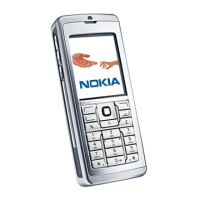Creating Internet connections
8
Copyright © 2006 Nokia. All rights reserved.
• TKIP encryption — To enable TKIP encryption, based
on transient keys changed often enough to prevent
misuse, select Allowed. All devices in the wireless
LAN must either allow or prevent the use of TKIP
encryption.
If you selected 802.1x as the WLAN security mode,
define the following in WLAN security sett.:
• WPA mode — Select EAP if you want to use an EAP
module for authentication. If you select Pre-shared
key, type the password (also called a master key) in
the field. Note that the same key must be entered in
the wireless LAN access point.
• EAP plug-in settings — If you selected EAP, you must
also define these settings. See page 9 for more
information.
Note: 802.1x authenticates and
authorizes devices to access a wireless
network, and prevents access if the
authorization process fails.
If you selected WEP as the WLAN security mode, define
the following in WLAN security sett.:
• WEP key in use — Select which WEP key is used (#1-
#4).
• Authentication type — Select Open or Shared.
• WEP key settings — The remaining settings are
defined here:
WEP encryption — Select the desired WEP encryption
key length. Supported options are 64, 128, and 256
bits. The more bits there are in the key, the higher
the level of security. WEP keys consist of a secret key
and a 24-bit initialization vector. For example, some
manufacturers refer to the 104-bit key as a 128-bit
key (104+24). Both keys offer the same level of
encryption and are therefore interoperable.
WEP key format — Select whether you want to enter
the WEP key data in Hexadecimal format or in text
format (ASCII).

